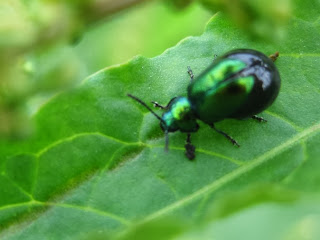 |
| Gastrophysa viridula |
A few months ago, I had the opportunity to go to Austria to study the diurnal butterfly diversity. I spent several hours doing field work, going to meadows and grasslands, observing these winged bugs. I was focused on identify butterflies, however, I could not ignore the amount of other insects there were (some of them quite annoying, by the way).
I would like to share with you, some of the pictures I could take to this spectacular wildlife. To avoid upload all the pictures in one post, I will split them in several posts. So, this one is the first of a series of posts about the insects I found in Austria. First, I will show you beetles, bees, butterflies and others insects I found on the field. After that, I will upload pictures of bugs I found in my bedroom! My window was quite big, and front of it there were a few gardens and trees that pushed several insects to come to my room.
 |
| Coccinella septempunctata |
First of all I would like to apologize for the quality of some of the photos. I only have a compact camera, so it's not my aim to compete with those blogs with amazing pictures I found here and there.
I also found out that most of the bugs and butterflies I spotted these weeks are quite common, but I had no idea! Now, when I'm going to the field to observe birds, I can't focus only on birds, my attention now is shared with other forms of life.
 |
| Cetonia aurata |
 |
| Rhagonycha fulva |
Other beetles were also spotted. The Common red soldier beetle (Rhagonycha fulva) was one of the most seen, and I had seen it before in other places (almost always like in the photo). Although it likes to be on flowers, this species is carnivorous and can eat small insects that find there.
The green dock beetle (Gastrophysa viridula) has a strong relationship with the plants of genus Rumex, which it eats as an adult and as a larvae.
The bee beetle (Trichodes apiarius, common name also shared with other species) is a species which feeds on the pollen and small insects it hunts. As a larvae, it's a parasite of bees (hence its name).
And this is the beetle's post. I have to thank the people of the Wild About Britain's Forum because they helped to identify some of this species very fast.
This is my first approach to the world of the insects and I'm confirming (I knew it anyway) that it's huge, and it's not going to be easy to have a general knowledge of the general groups. Not to say about species.
I would like to know what experiences do you have with them (if any) and how did you start study/observe those tiny things :)
 |
| Trichodes apiarius |
The bee beetle (Trichodes apiarius, common name also shared with other species) is a species which feeds on the pollen and small insects it hunts. As a larvae, it's a parasite of bees (hence its name).
 |
| Hoplia philanthus |
This is my first approach to the world of the insects and I'm confirming (I knew it anyway) that it's huge, and it's not going to be easy to have a general knowledge of the general groups. Not to say about species.
I would like to know what experiences do you have with them (if any) and how did you start study/observe those tiny things :)

No comments:
Post a Comment